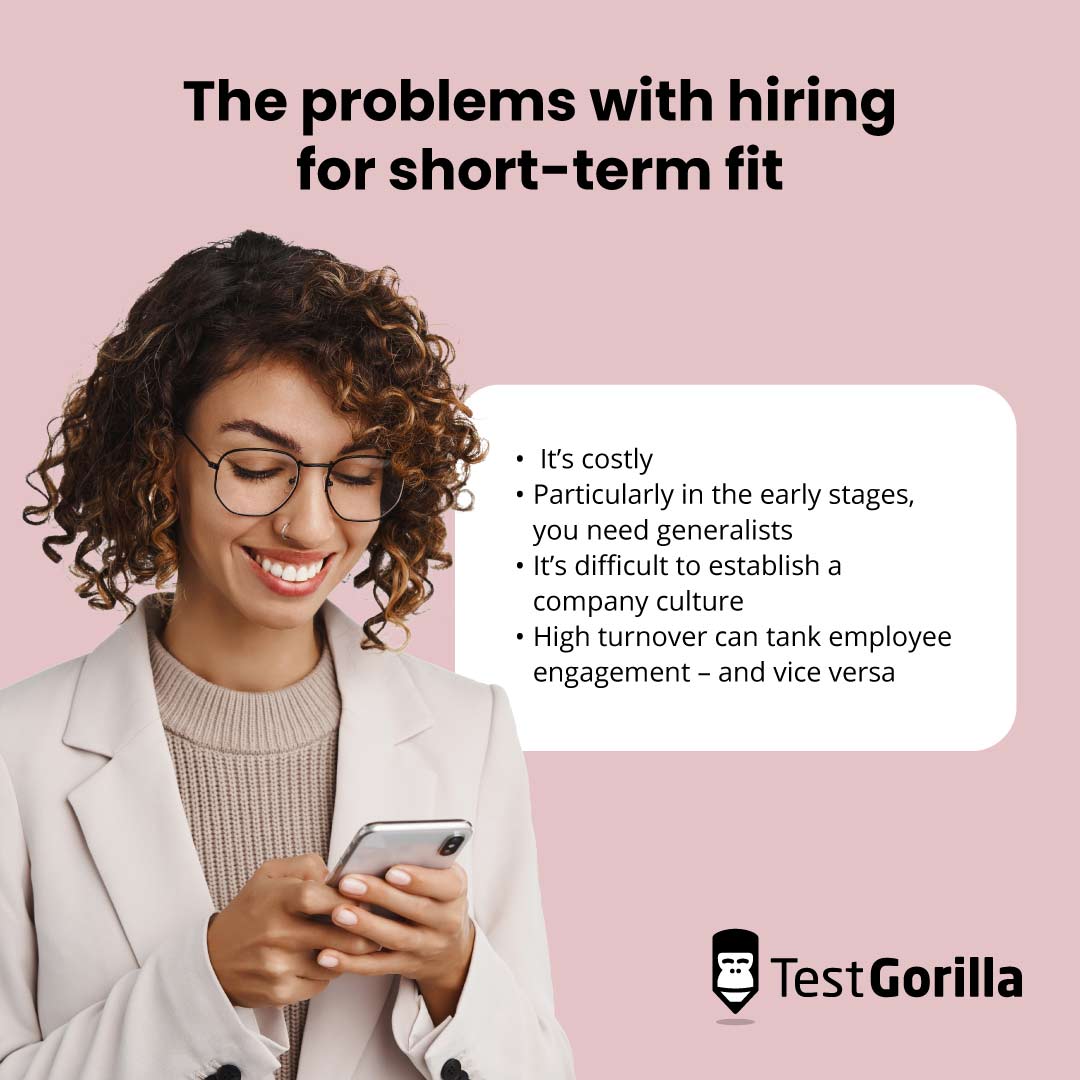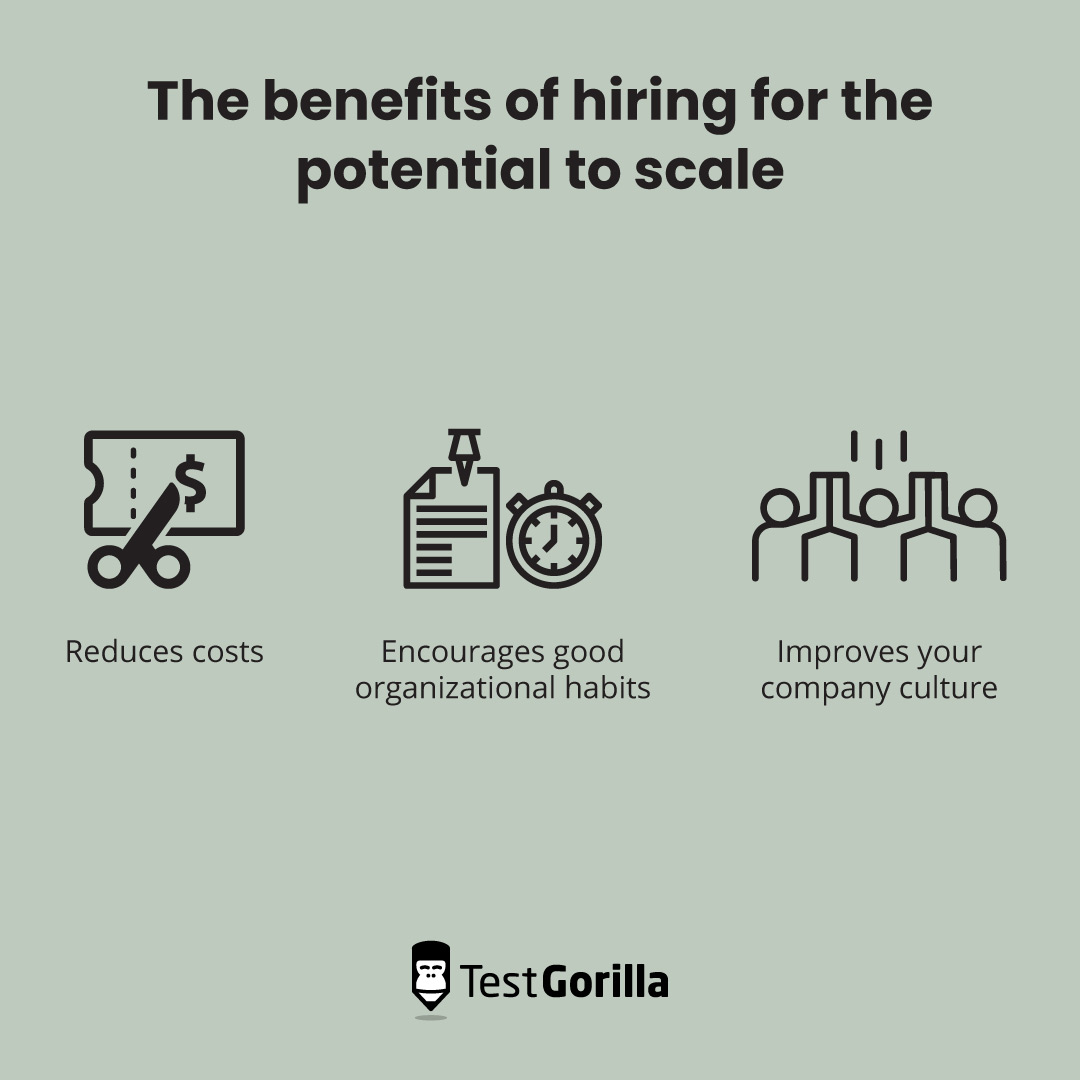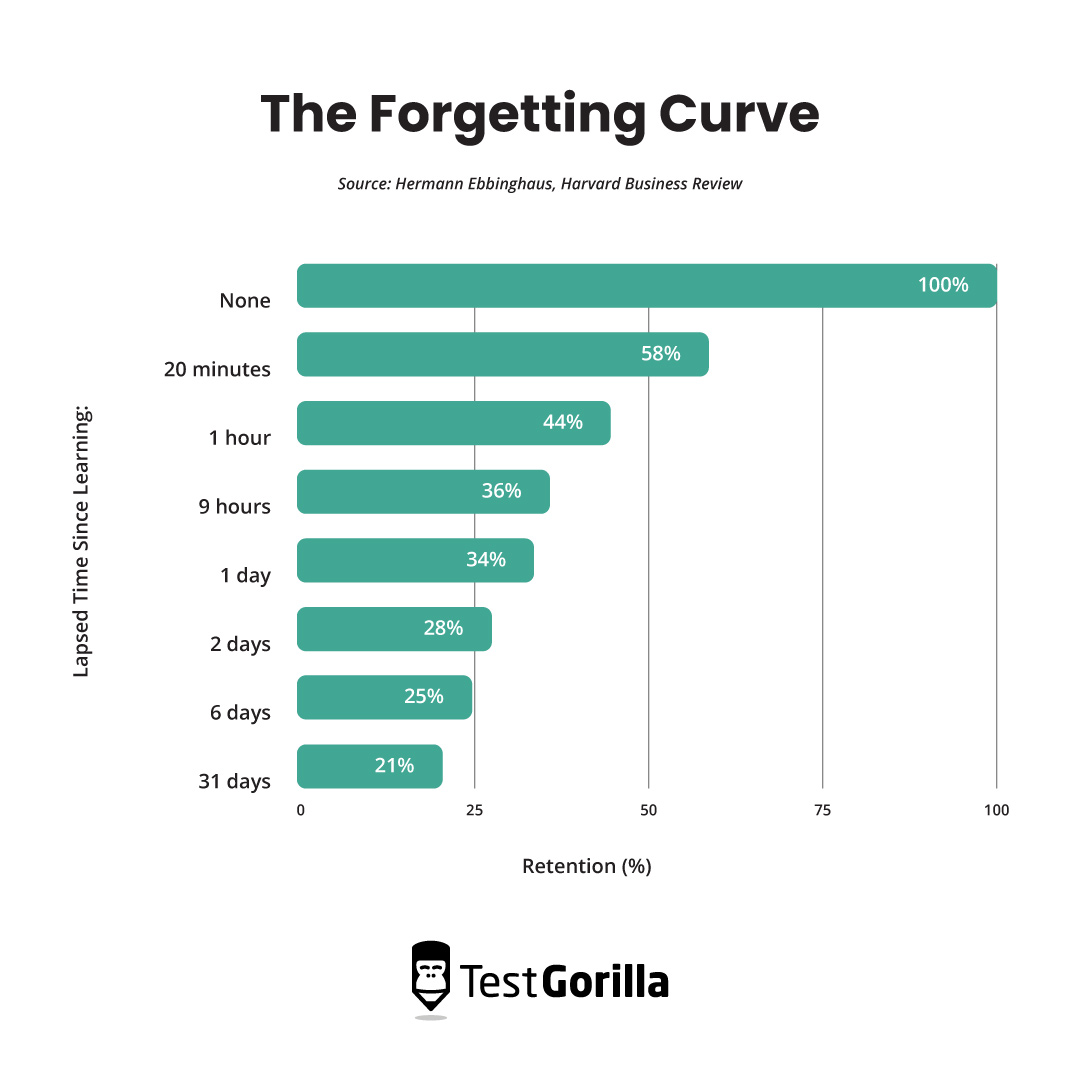Hiring for startups: Should you hire for a short-term fit or the potential to scale?
When you’re launching a startup, building the right team is everything: 14% of startups fail due to not having the right people on board.[1]
And yet, it’s fraught with complications.
Let’s say you’ve identified social media as a key engine for your brand’s growth in the next six months. You know you need a dedicated team member to craft your strategy and manage your channels, but when it comes to hiring, you find yourself in a bind.
One of your candidates is highly skilled in social media management and would undoubtedly maximize the effectiveness of your social media push in the short term – but their long-term career goals don’t align with your vision for the role.
Your other candidate isn’t as experienced, so their effectiveness in the short term might be less impressive. However, they’re keen to progress with your company, and they have a broad range of additional marketing skills that could inform your other initiatives.
Who do you prioritize: the candidate who provides the best short-term fit, or the one with the most potential to scale with you?
This dilemma is one of the most challenging parts of HR for startups, and we’re here to help you navigate it.
In this blog, we take you through the benefits and drawbacks of hiring for short-term fit vs. the potential to scale, when it’s appropriate to use each strategy, and the best practices for doing so.
Table of contents
- What’s the difference between short-term fit and potential to scale?
- Hiring for short-term fit
- Best practices when hiring for short-term fit
- Hiring for the potential to scale
- Best practices for hiring for the potential to scale
- Use skills-based hiring to build a startup team that can go the distance
- Sources
What’s the difference between short-term fit and potential to scale?
Much like hiring for experience vs potential, hiring for short-term fit vs the potential to scale is all about weighing your short-term priorities against your long-term view of your business.
Most times, short-term fit manifests itself as a candidate being highly specialized for the role as it exists at this stage in your growth.
In the example we gave above, that means someone who’s highly skilled in running social media ads. They’d supercharge their function, but perhaps only in the short term. A common reason for this is that their career plan diverges from your vision of the role.
For example, you might hire a senior developer who’s been working as a freelancer. They’re ideal for the short-term project of getting an app up and running; however, they don’t want to progress up the ranks to chief technology officer, which is where you see this role heading.
A candidate with the potential to scale, on the other hand, would have:
A career plan that aligns with your expectations of the role progression
A broader skill set that nonetheless meets a baseline technical requirement for the role at hand
The flexibility and soft skills to adapt to the needs of the business
Hiring for short-term fit
There are obvious reasons for prioritizing short-term fit when hiring for a startup, the main one being that nothing is guaranteed.
Almost 67% of startups stall at some point during the venture capital fundraising process, failing to “exit” (when the founder leaves the business) or raise follow-up funding.[2]
Your business might not exist in six months or a year; you need everyone to be firing on all cylinders to have the best chance of reaching that long-term future you’ve dreamed about.
Hiring the most effective person for the short term might seem like the best strategy to do this. However, this isn’t always the case
The problems with hiring for short-term fit
There are many problems with hiring someone because they would expedite your short-term vision for your organization but don’t show potential for long-term growth.
Here are a few of the biggest ones:
1. It’s costly
We all know that hiring is expensive, and nowhere needs to be mindful of its spending like a startup.
The average cost-to-hire in the US in 2017 was more than $4,000 according to the Society for Human Resource Management (SHRM), and the effects of the pandemic mean that this figure is likely even higher now.[3]
This is because employers are currently operating in a “candidate’s market,” which is an employment market with more job vacancies than skilled professionals to fill them. As a result, job candidates with developed technical skills can negotiate higher pay.
A report by Betterworks found that many organizations are not only taking longer to fill roles but that new hires are demanding the highest average salaries in a decade.
Startups are not immune to these difficulties: 71% of startups say that they find it at least somewhat challenging to find the necessary skills for their business.
So, while you may benefit in the short term from having a specialist on board to supercharge your initiatives, in the long term their leaving could tear a hole in your budget.
2. Particularly in the early stages, you need generalists
As we’ve already mentioned, one of the reasons that a candidate might be a good short-term fit but not offer long-term potential is because their experience and skill set is tailored specifically to meet your present needs.
This might make them less willing or able to pitch in with other tasks and take initiative with other projects, which are both essential in the early days of a startup.
They might also be less adaptable over time as your business needs change. This could happen quicker than you expect.
The agile methodology teaches us to constantly question whether our approach to problem-solving is right and to change it if it isn’t.
A candidate hired for short-term fit presents a specific, short-term solution you might need to throw out, leaving you with an employee who isn’t able to adapt.
3. It’s difficult to establish a company culture
When you hire for short-term fit, you’re accepting that this employee probably won’t be with you for the long haul. In many cases, they may not share your vision for the organization or have a deep connection to its values.
But although they might not stick around, the effect of their departure will.
With new employees coming and going through a revolving door, it’s very hard to create a positive workplace culture founded on mutual respect and trust between employees.
If they don’t feel connected to your mission, this might also sow disinterest among your remaining team members.
Both of these issues pose particular challenges as you scale. Job seekers rank company culture very highly when considering a new role, with 86% saying it is somewhat or very important.
4. High turnover can tank employee engagement – and vice versa
Finally, the high turnover that comes from routinely hiring for short-term fit can tank employee engagement and overall profitability.
Low retention is linked to low engagement, and low engagement teams have turnover rates up to 43% higher than their highly engaged counterparts.
Engagement is key to profitability because organizations that score in the top quartile for employee engagement are 23% more profitable than those in the bottom quartile.
In the worst cases, this high-turnover environment could turn into a harmful “churn and burn” culture, with employees rapidly being hired and fired or quitting due to burnout – neither of which creates the positive company culture needed to stand out to top talent.
Is it ever right to hire for short-term fit?
We’ve assembled a pretty strong case so far against hiring for short-term fit, but are there ever times in the startup hiring lifecycle when you should prioritize short-term needs over a long-term view?
When you’re hiring for a time-bounded project
It might be a good idea to hire for short-term fit instead of the potential to scale when you urgently need skills that won’t be essential for the long-term running of your business.
For example, you might need an in-house developer to set up your tech stack, but if you’re not a digital business, you might not need their skills to grow further.
In this case, hiring on a project basis might be the best option, with a time window in mind for completion to limit the upheaval it causes when the project reaches its end.
When you’ve reached maturity and stability
At some stage, you will need to start hiring specialists to fill roles, but probably not until you reach some sort of stability.
The HR function is a good example: Most sources recommend that startup leaders manage HR initiatives themselves until after a Series A round of funding, or the team has grown to around 20-30 employees.
At that point, it’s best to hire a dedicated HR professional to manage hiring, wellbeing, and development initiatives.
However, while you don’t need the same focus on flexibility, you should still look beyond the short term when hiring for these roles and seek at least some potential to scale with your organization.
Best practices when hiring for short-term fit
If you are in one of the situations we’ve outlined above and find yourself wanting to make a short-term hire, here are some best practices to ensure you do it with the least damage to your organization.
1. Tailor your job description to attract the right candidates
If you’re hiring for short-term fit, it’s likely that you need to find the right fit fast. For that, you need to attract the right job applicants with your job ad. The best way to do this is by focusing on skills over experience.
Many employers look at the number of years of experience a candidate has to tell them how well they will perform on the job or how long they will stay in the role. However, pre-hire work experience is not a proven predictor of job performance or retention.
Instead, focus primarily on the core skills for the role and remove unnecessary requirements like four-year degrees. In their place, describe the responsibilities attached to the role – then use our next tip to see how they measure up.
2. Ensure candidates have core technical skills and good communication skills
When you’re hiring someone for short-term fit, skills are perhaps even more important than usual because you have a specific purpose in mind for their role.
Instead of relying on the resume, that old middle man, to tell you what a candidate’s skills are, take a skills-based hiring approach and measure them directly using pre-interview skills testing.
With short-term fit, it’s even more important that a hire is equipped to hit the ground running. They need not only the core technical skills required for the role but also the soft skills that make them a valuable addition to the team.
For example, you might look for:
Communication skills: to help them work more efficiently with your team
Self-efficacy: the ability to direct their own work without waiting to be told what to do
Critical thinking or problem solving: the skill of using their expertise to help craft the best course of action, rather than just doing as you say
3. Document your processes so that you don’t lose their institutional knowledge
Even if your employee may only be with you for a short while, you need the knowledge they acquire about your company and its processes to stay within your organizational ecosystem.
One study found that as much as 42% of valuable company knowledge is unique to each employee, and the loss of this knowledge can cause problems when they leave.
To avoid this, you should be documenting processes like:
Decision-making process for key projects
Outreach to and interactions with vendors and other industry contacts
Research for any upcoming projects
Having this information on hand makes handover smoother, which means fewer stressed-out employees and an uninterrupted workflow.
Hiring for the potential to scale
Hiring for short-term fit, then, is imprecise and often damaging.
But is hiring for the potential to scale any better? Even the most sophisticated startups can’t see into the future.
How can you be sure that a candidate has the potential to grow with your organization?
What does potential look like in startup hiring?
We know that people see the word “potential” and often assume it means “young,” but the people with the most potential to scale with your organization may not be young at all.
What potential really refers to is a host of soft skills that make people adaptable to change and growth.
This is perhaps especially true when hiring leaders for your executive team. One study conducted by McKinsey found that there are 20 leadership traits that correlate with organizational performance, all of which are related to four key soft skills:[4]
Insight: for instance, offering a critical perspective on a business problem
Integrity: giving praise and modeling organizational values
Courage: championing desired changes and remaining calm in the face of uncertainty
Agility: motivating teams and recovering from failures while maintaining positivity
These skills can manifest at any age and any experience level – not just fresh grads!
The benefits of hiring for the potential to scale
You might be able to guess some of the benefits of hiring for the potential to scale based on the disadvantages of the short-term view we laid out above. However, it’s important to understand how beneficial this process can be.
Here are the top three benefits.
1. It reduces your costs
One of the biggest benefits of hiring for the potential to scale is that it reduces the likelihood of incurring the costs we outlined above.
In fact, studies suggest that retaining a salesperson for an additional year – as well as adopting better onboarding and management practices overall – can save a company as much as $1.3m in value over a three-year period.[5]
Startup leaders may be able to access even greater savings if they use skills-based hiring methods to hire candidates since 89.8% of organizations saw a reduction in cost-to-hire after switching to skills-based hiring.
2. It encourages good organizational habits
By considering candidates’ capacity to grow with your organization from the very start of the hiring process, hiring for the potential to scale ingrains many good practices into your budding HR function.
First and foremost, it reminds you to identify opportunities for learning and development for all candidates from the start of their experience with you.
For example, you might use candidates’ performance on skills tests to identify the weaknesses that need further development. You could then create a professional development plan to help them progress through your organization.
This gives you an advantage when it comes to talent planning since you can set development targets for employees that align with your business goals.
You don’t have to leave it to chance that your employees reach the potential you hired them for – you can support them to actually do it.
3. It improves your company culture
Hiring for progression is a great way to reduce employee turnover, which has a big impact on your company culture.
Naturally, with more employees sticking around for longer, hitting their career targets, and contributing to a mission they deeply believe in, your organization develops a more cohesive culture than if you hired for short-term fit only.
Again, a skills-based approach to hiring and development can help you here: Deloitte research found that skills-based organizations were almost twice as likely to retain high performers and more than twice as likely to innovate.
Best practices for hiring for the potential to scale
With the above benefits in mind, we hope the message is clear: If in doubt, hire for the potential to scale.
Here are our best practices for using these methods to hire for the potential to scale.
Best practices for hiring for the potential to scale: Summary table
We get it – you’re a startup; you’re short on time. Here’s the short version.
Best practice | Example actions |
Ensure there is a need to hire | Calculate how much hiring will cost vs. alternatives like automation |
Create a detailed candidate persona | Test your existing employees to see the core skills they have in common |
Use skills-based hiring to find the right candidate without bias | Encourage interviewers to consult skills test results during the interview process to challenge their own bias |
Hire for culture add, not culture fit | Test for culture add while screening and probe deeper in interviews |
Use skills-based learning to support career progression | Use the lean learning technique so that employees apply their training immediately |
1. Ensure there is a need to hire
Part of your proactive recruiting strategy should be taking a critical view of every role that you consider adding to your team. You need to ask hard questions about three key areas:
The business needs it answers
Timing and cost of hiring
Alternatives to hiring
Category | Questions to ask |
Business need | Does this role fill a short-term and long-term need? How will it evolve over time? What training is needed to support hires? |
Timing and cost | Is now the right time to hire for this role? How much will it cost, and can you afford it? How will it help you achieve your immediate business goals, and what are the key performance indicators? |
Alternatives | Can this business need be answered through any other means, such as automation or outsourcing? |
While this seems like the sort of step you might be able to breeze over – you’re a startup leader, of course you know what you’re doing – it’s important that you take the time to properly cost the role and answer all of these questions. Otherwise, you might:
Find the right hire at the wrong time and end up having to let them go
Over-promise in terms of career progression and watch them quit
Waste the potential of a promising candidate by not providing the right support
2. Create a detailed candidate persona
Unlike in an established company, startup leaders can’t look at existing hires’ skills to understand what makes a high performer in your business since many of the roles you hire for will be the first of their kind in your organization.
For example, if you were hiring a new addition to a marketing team in a mature company, you might test the skills of your existing employees to see what skills your high performers possess – and, more importantly, the ones they lack.
To hire the right person for a startup, you have to take a slightly different approach. You might still test your existing team to see what skills they have, but rather than using these as a basis for your job ad, you might instead use them to create general candidate personas.
You might see that all of your team members have the qualities of flexibility, trust, and a multidisciplinary skillset. Therefore, when hiring, you might test for soft skills relating to flexibility and trust, as well as a wide range of other skills, looking for a candidate who:
Has skills in multiple technical areas, though without specific criteria for what these areas are
Is particularly proficient in one area that is directly relevant to the role
Supplies additional soft skills that aren’t currently present on your team
An example of the latter in action comes from Google. As a fledgling startup, Google was wary of bringing on new employees unless they brought in skills the existing team lacked.
They set a strict limit of 50 new hires for the whole year and brought in “Larry and Sergey dollars,” named for Google’s founders, which team leaders could either hand in to “pay” for a new recruit, or use to entice an existing employee with the skills they needed to work on their project.[6]
Under this system, managers became more thoughtful about how they scaled, prioritizing hiring for situations in which the necessary skills could not be found in-house.
3. Use skills-based hiring to find the right candidate without bias
For the most part, startup teams do not start out very diverse. Founders may all hail from the same college or prior employer, and many rely on referral networks to make new hires. This keeps the inner circle pretty small and like-minded.
As you begin to scale, you need to think more carefully about cultivating diversity. A 2020 McKinsey study showed that the relationship between diversity on executive teams and the likelihood of financial outperformance has strengthened over time.
Traditional hiring methods can’t help you with this. Even if you get a diverse set of candidates in the room, without data to support your hiring efforts, interviewer bias may still creep in.
Yale University researchers found that both male and female scientists preferred to hire men – even when they received training about objective hiring.[7]
This likely isn’t due to overt prejudice but a lack of data support for decision-making, forcing hiring managers to lean on unconscious biases to narrow down candidates.
Skills-based hiring gives you this missing data support. Skills testing in startup hiring offers a less biased means of shortlisting candidates and also gives interviewers a basis to challenge their own assumptions in interviews.
It really works: In a study of more than 2,000 successful job applicants, the number of women hired into senior roles increased by almost 70% when skills-based hiring was used.
4. Hire for culture add, not culture fit
One of the biggest factors for whether an employee has the potential to scale with your organization – and, crucially, whether they realize that potential – is based on the degree to which they share your organization’s values and believe in the work you do.
The way to look for this in your hiring is to throw out the old-fashioned notion of culture fit and embrace “culture add” instead.
Culture fit encourages recruiters to reproduce the superficial traits of your existing team, a practice that often leads to groupthink and even toxic cliques.
Culture add, on the other hand, is all about finding candidates who share your values and motivations but provide something new in terms of their skills or outlook.
Hiring for culture add ensures diversity of thought within your team while also combining it with unity of purpose, which bodes well for business success. Deloitte research shows that diversity of thinking increases innovation by about 20%.[8]
5. Use skills-based learning to support career progression
One of the reasons that skills-based hiring can transform your attitude toward retention is that it doesn’t just help you find employees who are likely to stay longer; its methods can also help you ensure they do.
Skills-based hiring techniques can be used in employee development and upskilling initiatives as part of the rising trend known as skills-based learning. This focuses on supplying employees with hands-on skills training that directly answers employers’ skill needs.
This is not just prudent but necessary because more than half of hiring managers anticipate technological interventions like workplace automation to change the kinds of skills they need from employees.
Upskilling can help you respond quickly to these challenges. Harvard Business Review recommends it as a direct tactic to improve organizational agility.
It works, too. Studies show 93% of chief executive officers see increased productivity, improvement in acquisition and retention, and more resilience in their workforce after introducing upskilling programs.
To best take advantage of these benefits, startups should combine the skills-based learning framework with the “lean learning” approach. Lean learning is about:
Identifying the core skills to target
Applying the training to real-world scenarios immediately
Receiving immediate feedback to refine the approach
Repeating the cycle until the skill is ingrained
The rapid application of skills is key here since it stops training from falling off the “forgetting curve,” which describes the diminishing capacity for individuals to recall training over time.
One important best practice for skills-based lean learning is to shift the emphasis from credits – or training modules completed – to outcomes. These might be:
Projects the training enables employees to take on
Improvements in performance in specific tasks
Better performance on skills tests
Use skills-based hiring to build a startup team that can go the distance
It’s the constant dilemma of any startup leader: seizing the moment and not taking anything for granted, while also building something that stands the test of time.
As we’ve seen, hiring for short-term fit might seem like a good idea, but more often than not, hiring for the potential to scale has both short- and long-term benefits for your startup.
To best access these benefits, you not only need to use the skills-based hiring tips we’ve given above but also need to dive deeper into skills-based hiring for startups.
To get an overview of what this entails, read our list of 7 best practices when hiring for startups.
As you add more people to your team, make sure to consult our guide to scaling hiring for tips and best practices.
And to find candidates whose values and vision align with yours, use our Culture Add test to hire the best.
Sources
“The Top 12 Reasons Startups Fail”. (August 3, 2021). CB Insights. Retrieved April 24, 2023.
“Venture Capital Funnel Shows Odds Of Becoming A Unicorn Are About 1%”. (September 6, 2018). CB Insights. Retrieved April 24, 2023.
“SHRM Customized Talent Acquisition Benchmarking Report”. (2017). Society for Human Resource Management. Retrieved April 24, 2023. https://www.shrm.org/ResourcesAndTools/business-solutions/Documents/Talent-Acquisition-Report-All-Industries-All-FTEs.pdf
Ritter, Ron; Ruggero, Ed. “Leadership in innovation needs innovation in leadership”. (October 2, 2017). McKinsey & Company. Retrieved April 24, 2023.
Josebachvili, Maia. (August 19, 2016). “How to understand the ROI of investing in People”. LinkedIn. Retrieved April 24, 2023. https://www.linkedin.com/pulse/how-understand-roi-investing-people-maia-josebachvili/
Danielson, Tess. (November 19, 2015). “Marissa Mayer explained how ‘Larry and Sergey dollars’ created a black market for hiring at Google”. Insider. Retrieved May 05, 2023. https://www.businessinsider.com/marissa-mayer-on-how-larry-and-sergey-dollars-created-a-black-market-for-hiring-at-google-2015-11?r=US&IR=T
Agarwal, Pragya. (December 3, 2018). “Unconscious Bias: How It Affects Us More Than We Know”. Forbes. Retrieved April 24, 2023. https://www.forbes.com/sites/pragyaagarwaleurope/2018/12/03/unconscious-bias-how-it-affects-us-more-than-we-know/?sh=3333fe6e13e7
Bourke, Juliet. “The diversity and inclusion revolution: Eight powerful truths”. (January 22, 2018). Deloitte Review. Retrieved April 24, 2023.
Related posts
You've scrolled this far
Why not try TestGorilla for free, and see what happens when you put skills first.
Latest posts
The best insights on HR and recruitment, delivered to your inbox.
Biweekly updates. No spam. Unsubscribe any time.

Skills tests to hire the best
Our screening tests identify the best candidates and make your hiring decisions faster, easier, and bias-free.
Free resources
A step-by-step blueprint that will help you maximize the benefits of skills-based hiring from faster time-to-hire to improved employee retention.
With our onboarding email templates, you'll reduce first-day jitters, boost confidence, and create a seamless experience for your new hires.
This handbook provides actionable insights, use cases, data, and tools to help you implement skills-based hiring for optimal success
A comprehensive guide packed with detailed strategies, timelines, and best practices — to help you build a seamless onboarding plan.
This in-depth guide includes tools, metrics, and a step-by-step plan for tracking and boosting your recruitment ROI.
Get all the essentials of HR in one place! This cheat sheet covers KPIs, roles, talent acquisition, compliance, performance management, and more to boost your HR expertise.
Onboarding employees can be a challenge. This checklist provides detailed best practices broken down by days, weeks, and months after joining.
Track all the critical calculations that contribute to your recruitment process and find out how to optimize them with this cheat sheet.

















